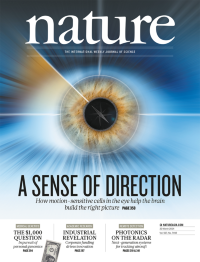Volume 507
-
No. 7493 27 March 2014
Can you keep secrets safe from eavesdroppers? Yes you can, say Artur Ekert and Renato Renner. They argue that recent developments in quantum cryptography, coupled with the fact that we still possess free will, suggest that truly private communication will always be possible, even in a world with access to as yet undiscovered code-breaking technologies. The answer lies in new insights into the nature of randomness and non-local correlations. Thus equipped it should be possible to outsmart even the most powerful surveillance procedures. Cover: Andy Potts
-
No. 7492 20 March 2014
The motion-detecting cells of the retina, called direction-selective ganglion cells (DSGCs), have been known about and studied for more than half a century but their precise role in visual processing has remained unclear. Using a combination of genetic, anatomical and imaging techniques, Andrew Huberman and colleagues investigate the connections made by DSGCs in the mouse brain and find that they link specifically to neurons in the superficial layers of primary visual cortex. Inputs from several different DSGC types are combined to convey both directional and orientation information to the cortex. In addition, non-direction-tuned information from the retina is sent to deeper layers of cortex. This reveals that the mouse visual system contains several functionally distinct parallel pathways and that directional and orientation selectivity in the cortex may arise from the earliest stages of visual processing involving motion-detecting cells in the retina. Cover: Kelly Krause/Nature � Santiago Cornejo/Shutterstock
-
No. 7491 13 March 2014
Microfluidics exploits the properties of fluids trapped in submillimetre-scale spaces � the physics behind inkjet printing, DNA microarrays, lab-on-a-chip chemistry and much else � to useful practical effect. In the past decade microfluidic devices have shown considerable promise in diagnostics and primary research in the biological sciences. In a Review in this issue, Eric Sackmann, Anna Fulton and David Beebe analyse the progress seen in lab-on-a-chip microtechnologies in recent years and discuss the clinical and research areas in which they have made � and may make � the greatest impact. Cover: Jasiek Krzysztofiak/Nature
-
No. 7490 6 March 2014
CRISPR/Cas9-based DNA targeting has quickly become a leading tool in the fields of synthetic biology and genome engineering. It exploits the ability of a bacterial endonuclease, Cas9, guided by an RNA molecule, to target virtually any matching DNA sequence of interest for binding and/or cleavage. A study published in this issue of Nature reports the use of single-molecule and bulk biochemical experiments to reveal the mechanism by which RNA-guided Cas9 locates unique 20-base-pair sequences within DNA genomes, which can be billions of base pairs long. The results highlight the role of a trinucleotide protospacer adjacent motif (PAM; yellow in the cover image) in recruiting Cas9RNA complexes to potential DNA target sites, and in catalytically activating the nuclease (outlined in brown). Target DNA sequences are recognized via a zip-up� mechanism, where the sequential formation of RNADNA base pairs (red) offsets the energetic cost of unwinding the DNA double helix (purple and blue). In addition to its relevance for gene manipulation, this work reveals how DNA is interrogated by Cas9RNA in its role as an effector of adaptive immunity in bacteria. Cover: K. C. Roeyer.




